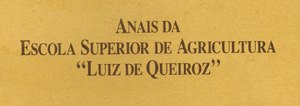Resumos
Resumimos, neste trabalho, os resultados das observações sobre a adaptação fenotípica de raízes de várias plantas, tais como grama-batatais - Paspalum notatum, quebra-pedra ou erva-pombinha Phyllathus ninuri, maria-preta - Solanum nigrum, carurú - Amaranthus sp., tiririca - Cyperus rotundus e outras, com os frutos encontrados no solo da palmeira Dictyosperma rubra Wendl. & Drude, cultivada como ornamental no Parque da Escola Superior de Agricultura "Luiz de Queiroz". Essa adaptação caracteriza-se pela penetração das raízes através de orifícios circulares, existentes no pericarpo dos frutos, e produzidos por uma broca da família Bostriquide, da ordem Coleoptera. As raízes assim assemelham-se a um colar. Diante desse fato, decidimos montar um experimento que nos permitisse elucidar o mecanismo dessa curiosa adaptação fenotípica.
It was verified phenotypic adaptation of roots of several plants (Paspalum notatum, Phyllanthus minuri, Solanum nigrum, Amaranthus sp, Cyperus rotundusand others) with fruits found in the soil of the palm-tree Dictyosperma rubra Wendl. & Drude cultivated as ornamental plant in the ESALQ park. This adaptation characterized by the penetration of roots through the round orifices found in the fruit pericarp promoted by an insect of the Bostriquide family and Coleoptera category. An experiment was realized in a plastic box with layers of soil alternated with layers of palm fruits without perforations. It was used the same weeds found near of the palm-tree in the park. It was verified after three months that the roots did not perforate the fruits, showed that the insects was not present in the soil.
Walter Radames AccorsiI; Myrthes A.S. de BarrosII
IProf. Chefe do Departamento de Botânica da ESALQ-USP
IIProf.ª Ass. Doutor do Dept.° de Botânica da ESALQ-USP
RESUMO
Resumimos, neste trabalho, os resultados das observações sobre a adaptação fenotípica de raízes de várias plantas, tais como grama-batatais - Paspalum notatum, quebra-pedra ou erva-pombinha Phyllathus ninuri, maria-preta - Solanum nigrum, carurú - Amaranthus sp., tiririca - Cyperus rotundus e outras, com os frutos encontrados no solo da palmeira Dictyosperma rubra Wendl. & Drude, cultivada como ornamental no Parque da Escola Superior de Agricultura "Luiz de Queiroz".
Essa adaptação caracteriza-se pela penetração das raízes através de orifícios circulares, existentes no pericarpo dos frutos, e produzidos por uma broca da família Bostriquide, da ordem Coleoptera. As raízes assim assemelham-se a um colar.
Diante desse fato, decidimos montar um experimento que nos permitisse elucidar o mecanismo dessa curiosa adaptação fenotípica.
SUMMARY
It was verified phenotypic adaptation of roots of several plants (Paspalum notatum, Phyllanthus minuri, Solanum nigrum, Amaranthus sp, Cyperus rotundusand others) with fruits found in the soil of the palm-tree Dictyosperma rubra Wendl. & Drude cultivated as ornamental plant in the ESALQ park.
This adaptation characterized by the penetration of roots through the round orifices found in the fruit pericarp promoted by an insect of the Bostriquide family and Coleoptera category.
An experiment was realized in a plastic box with layers of soil alternated with layers of palm fruits without perforations. It was used the same weeds found near of the palm-tree in the park. It was verified after three months that the roots did not perforate the fruits, showed that the insects was not present in the soil.
Texto completo disponível apenas em PDF.
Full text available only in PDF format.
LITERATURA CITADA
Entregue para publicação em 31-12-1977.
Referências bibliográficas
- EPSTEIN, E. 1975. Nutrição mineral das plantas: princípios e perspectivas. Ed. Univ. S. Paulo/Livros Técnicos e Científicos Ed., Rio de Janeiro. 341 p.
- BIDWELL, R.G.S. 1794. Plant Physiology. Macmillan Publi. Co. New York. 643 p.
- SALISBURY, F.B.; ROSS, C. 1969. Plant Physiology. Wadsworth Pttbl. Co., Belmont. 747 p.
Datas de Publicação
-
Publicação nesta coleção
17 Maio 2012 -
Data do Fascículo
1977

 Adaptação fenotípica de raízes de várias plantas com frutos de Dictyosperma rubra Wendl. & Drude encontrados no solo
Adaptação fenotípica de raízes de várias plantas com frutos de Dictyosperma rubra Wendl. & Drude encontrados no solo